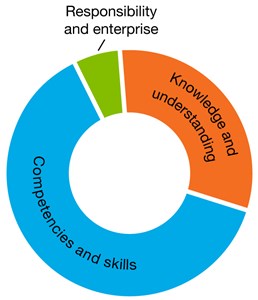Explore content
Mathematics
The Australian Curriculum: Mathematics has a significant role in developing consumer and financial literacy in young people. The Mathematics curriculum supports the development of the dimensions of consumer and financial literacy as shown in the diagram below.

Approximate proportion of dimensions addressed in Mathematics
Key aspects of financial mathematics are included in the money and financial mathematics sub-strand of the Mathematics curriculum. Here, students learn about the nature, forms and value of money. They learn to solve problems involving money, such as counting change; to manage money by creating budgets and financial plans; to explore and calculate percentage discounts; to work out ‘best value’ when purchasing a range of goods and services; to choose financial products and to solve problems involving profit and loss, and simple and compound interest.
Consumer and financial literacy provides a real-world context for students to learn other mathematics in the curriculum. Using authentic learning experiences engages students in mathematics, enables them to gain an understanding of a whole range of mathematical concepts and allows them to appreciate the relevance and usefulness of mathematics. The use of real-world contexts as a platform for learning mathematics also develops students’ ability to make informed judgements and effective consumer and financial decisions.
The content descriptions relevant to consumer and financial literacy are drawn from the strands number and algebra, and statistics and probability. These strands give students opportunities to ‘think and do’ mathematics in contexts that are real and engaging. For example, students might be asked to calculate the money they save by purchasing an item on sale (number and algebra); conduct an investigation into people’s purchasing preferences (statistics and probability); calculate monetary risks through the construction and use of mathematical models (number and algebra); or evaluate the benefits of insurance given the probability of an event occurring (statistics and probability).
The strand of measurement and geometry has not been included in this mapping. However, there are opportunities to include aspects of this strand in the teaching and learning of consumer and financial literacy. For example, students might compare the volume or capacity of different products to calculate best buy, or do some costings for materials, based on measurements. An example is provided in the Moneysmart for teachers unit ‘It’s raining cats and dogs ... and chickens?’, in which students explore different pet enclosures in terms of area and perimeter, using correct units.
Moneysmart for teachers and Tax, Super and You provide a number of interdisciplinary units and interactive activities that either focus on or include aspects of the Mathematics curriculum. Access a list of relevant resources that link to the Australian Curriculum: Mathematics using the right-hand menu.
Years F-2 Digital activity – Money match
Years F-2 Digital activity – Needs and want
Years F-2 Digital activity – Pay the price
Years F-2 Digital activity – Goods and services
Year 3 The house of needs and wants
Year 4 How much love can fit into a shoebox?
Years 2-4 Digital activity – Money and people
Years 2-4 Digital activity – Money maps
Years 3-4 Digital Activity – Party time
Year 5 Never too young to be Moneysmart with clothes
Year 5 Hey! Let’s have a big day out!
Digital activity – MilbaDjunga – Smart Money – Primary Unit
Year 6 The fun begins: Plan, budget, profit!
Year 6 It’s raining cats and dogs... and chickens?
Years 3-6 Digital activity – Helping out
Years 5-6 Digital activity – Calls, messaging and browsing
Years 5-6 Digital activity – Choosing a mobile plan
Years 5-6 Digital activity – Entertainment
Years 5-6 Digital activity – Fun day out
Years 5-6 Digital activity – Mobile credit
Years 5-6 Digital activity – Our-big-weekend-adventure
Years 5-8 Digital activity – Mobile phone security
Year 7 How can we reduce our spending?
Year 8 How can we access money overseas?
Years 7-8 Digital activity – Advertising
Years 7-8 Digital activity – Premium services
Years 7-8 Digital activity – Social media
Years 7-8 Digital activity – Consumer rights
Years 8-9 MilbaDjunga SmartMoney – Secondary unit
Year 9 How can we obtain more money?
Year 9 Mathematics – smart consumers 4 a smart future – Solar sums
Years 9-10 – MoneySmart Rookie – First car
Years 9-10 – MoneySmart Rookie – Credit and debt
Years 9-10 – MoneySmart Rookie – Moving out of home
Years 9-10 – MoneySmart Rookie – Online financial transactions
Years 9-10 – MoneySmart Rookie – First job
Years 9-10 Digital activity – Shopping for a mobile
Years 9-10 Digital activity – Online shopping and banking
Year 10 Reaching goals: What’s involved?
Year 10 Mathematics – smart consumers 4 a smart future – Money matters
Years 7-10 Your Tax: Activity 4 – Calculating tax due
Years 7-10 Your Tax: Activity 5 – What other taxes do I have to pay?
Years 7-10 Business Tax: Activity 2 – Business structures
Years 7-10 Super: Activity 4 – How do I choose a super fund?
Number and place value
Develop confidence with number sequences to and from 100 by ones from any starting point. Skip count by twos, fives and tens starting from zero (ACMNA012)
Recognise, model, read, write and order numbers to at least 100. Locate these numbers on a number line (ACMNA013)
Count collections to 100 by partitioning numbers using place value (ACMNA014)
Fractions and decimals
Recognise and describe one-half as one of two equal parts of a whole. (ACMNA016)
Money and financial mathematics
Recognise, describe and order Australian coins according to their value (ACMNA017)
Number and place value
Represent and solve simple addition and subtraction problems using a range of strategies including counting on, partitioning and rearranging parts (ACMNA015)
Data representation and interpretation
Represent data with objects and drawings where one object or drawing represents one data value. Describe the displays (ACMSP263)
Choose simple questions and gather responses and make simple inferences (ACMSP262)

